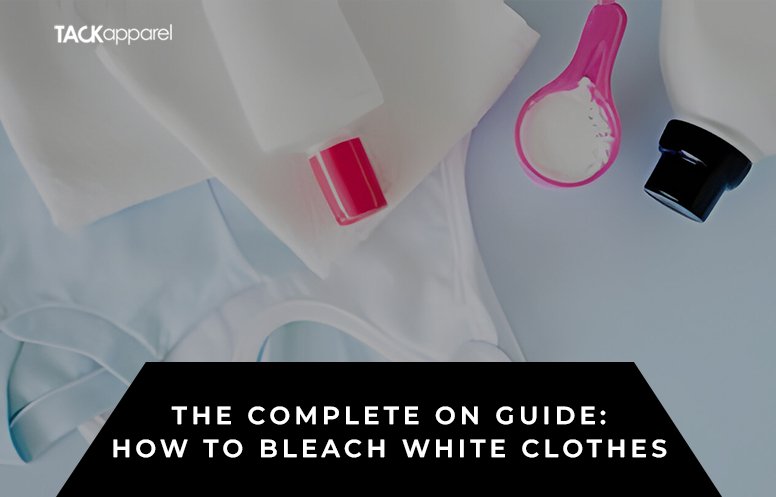Is the color of your white shirt becoming a little more “tan” or “grey” recently? Do you long to have that dazzling, sparkling white “new shirt” back? You can, if you use a little bleach! Bleach is a quick, simple, and cost-effective method for achieving brilliant, sparkling whites on different types of fabric.
Over time, white clothing may gradually become less dazzling or even begin to become yellow. They are also quite susceptible to discoloration. Fortunately, you can quickly bleach them to remove any discoloration and bring back their original brightness.
How to bleach clothes? It is possible to remove stains and dull appearances from clothing without causing harm to it by using safe tactics and bleaching methods. You can use a washing machine that can clean everything to avoid destroying your garments, or you can soak your white items by hand.
See more about the techniques for how to bleach white clothes by continuing to read.
3 Best Ways to Bleach White Clothes
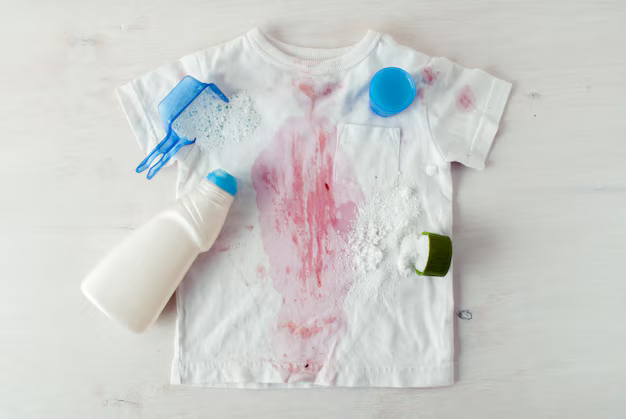
How to wash white clothes with bleach? By soaking them in a pail of cold water, adding bleach, and letting them sit for ten minutes or so, you can use bleach for white clothes. Then, remove the items, rinse them in cold water, and spread them out to dry. To enhance comprehension, the best way to bleach white clothes is:
Soak Your Clothes In Bleach
1. Pour Cold Water into a Bucket and Add your Shirt.
How to bleach clothes white? Put the clothing in a bucket, bowl, or other appropriately robust container to start. Add a couple of inches of cold water on top of it.
- Feel free to use your shirt to soak other people’s whites. Bleaching several items at once is more efficient than bleaching one. Towels, pillowcases, socks, and white undergarments are frequently excellent options. If so, add enough water so that when the clothing is pressed down, at least an inch or two of water covers them.
- You should use a container large enough to allow you to shake and move your clothes around while they soak. This is a terrific use for clean construction-grade buckets. It will reduce fumes when used indoors and help prevent accidents if you can find one with a cover. A big cooking pot, a bathtub, or your washing machine are other common options.
2. Put in Some Bleach
There’s a good chance that the instructions on your bleach container specify the suggested dosage. The concentrations of different bleaches vary. You might only need a few tablespoons or so if you are only soaking your clothing. However, you might need to add up to 1 cup if you soak a lot of whites. Generally speaking, one gallon of water should include around 1/4 cup of bleach. If your cloth is dirty and requires more than just whitening, you might wish to use additional cleaning products to give it even more cleaning power!
3. Give the Clothing Five to Ten Minutes to Soak.
Next, give the liquid in the bucket a good swirl to guarantee that your shirt and any other clothing it comes in get a nice, even soak. Then, simply wait the five to ten minutes that the timer indicates for the bleach to work! To make sure the garment soaks completely, you might want to agitate it every few minutes.
- Don’t soak your whites for an extended period. Long-term bleach exposure will eventually weaken and harm even materials like cotton and linen that can be properly bleached.
4. Use Cold Water to Rinse the Clothing.
After the shirt has soaked, take it out of the bleach mixture and give it a good wash in cold, clear water. This is what you should do to get the bleach and other chemicals out of the cloth. These substances have the potential to leave undesirable residues in the fabric that may create yellow stains, skin irritation, and a strong chlorine odor if left to dry.
5. After Drying, Wring Out the Shirt.
Squeeze or wring out as much water as possible from your garment after it has been rinsed and cleaned, making sure to eliminate any bleach or detergent residue. Next, just dry it as you would usually. For the majority, the most straightforward choice will be to use a drying machine or hang it outside to dry normally.
- Alternatively, you might leave the shirt outside to dry naturally. It is known that drying white clothing in the sun has a tiny “bleaching” effect that makes whites appear whiter (see the section below for more information). Sunlight-bleaching clothes is a real thing, though not as drastic as chemical bleach.
Using a Washing Machine to Bleach Clothes
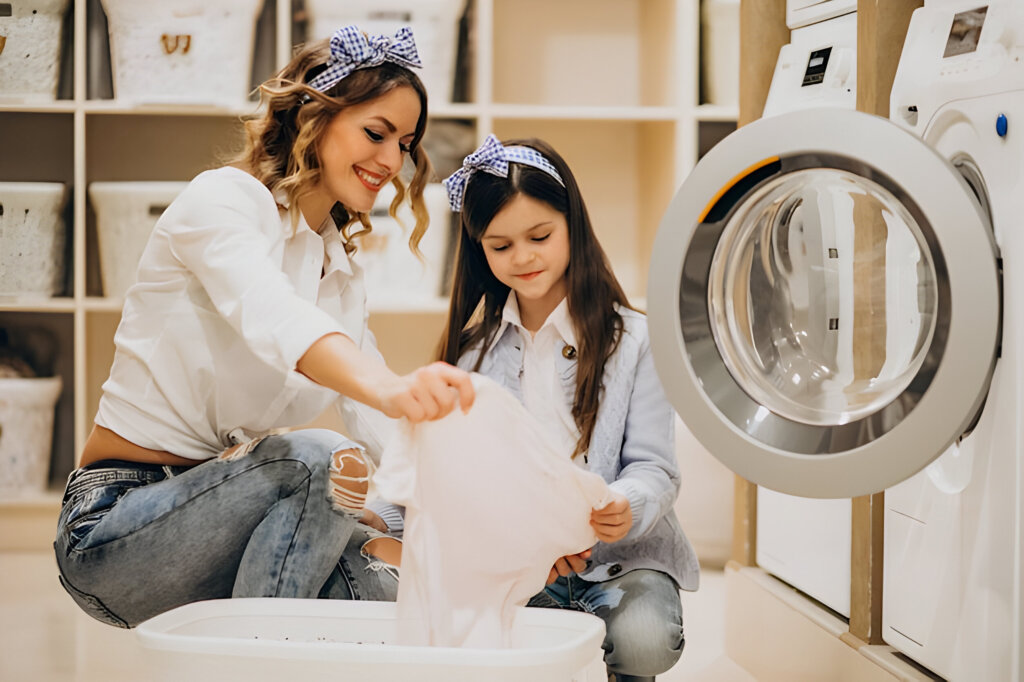
To keep your whites looking their best, bleach is the ideal solution. Towels and cloth diapers are two examples of filthy textiles with dense fibers that work well for disinfecting. Before using bleach in your washing machine, make sure to refer to your instructions!
1. Selecting the Right Bleach
Selecting the appropriate kind of bleach is the first step in bleaching white clothing. Although it can be harsh and harmful, chlorine bleach is the most popular type of bleach used for white textiles. A better substitute that works better on fragile textiles is non-chlorine bleach. It’s crucial to check if the bleach bottle is appropriate for the garment you’re bleaching by reading the instructions on it.
2. Arrange the Clothes
It’s time to get the items ready for bleaching once you’ve selected the appropriate kind of bleach. Sort the garments into colors and whites first. This will lessen the likelihood of any color transferring to the whites. Next, confirm that the clothing may be bleached safely by reading the care label. It is advisable to refrain from bleaching an item if the care label states, “Do not bleach.”
3. Lightly Dilute the Bleach
Next, before applying the bleach, it is crucial to dilute it. This will assist in avoiding any fabric damage. Combine one part bleach with four parts water to make chlorine bleach. Mix one part bleach with ten parts water to make non-chlorine bleach.
4. Put it in the Washing Machine
The bleach should be added to the washing machine once it has been diluted. Before adding the clothing to the machine, add the diluted bleach. To determine the proper amount of bleach to use, carefully read the instructions on the bottle.
5. Apply the Applicable Cycle
Using the appropriate cycle is crucial once the items are in the washing machine. For chlorine bleach, utilize the longest cycle and the hottest water setting. Use the warmest water setting and the shortest cycle for non-chlorine bleach.
6. Thoroughly Rinse
It’s crucial to give the garments a good rinse after the cycle. This will lessen the chance of any bleach residue remaining and shield the fabric from deterioration.
9. Appropriately Dry off
Ultimately, it’s critical to properly dry the clothing. Use the dryer’s lowest heat setting for chlorine bleach. Let the garments air dry if using non-chlorine bleach.
You may safely bleach white clothes without causing any damage by following these procedures. It is crucial to keep in mind that before bleaching, you should always read the care label on the clothing and the directions on the bottle of bleach. By doing this, you can make sure that your clothing keeps its quality.
The Sun-Bleaching Method

- First, wash your whites the way you always have.
- The second step is to rinse the garments and hang them on a rope, drying rack, or spotless flat surface. Make sure it’s warm outside and there’s no risk of rain. It will perform best in bright light.
- Hang your clothing outside to dry in the sun for a considerable amount of time. But avoid leaving the white clothing out in the sun for several days. It may weaken the clothing’s fabric, making it more susceptible to deterioration. So once they are dried, bring your clothing inside.
Follow Some Safety Tips Before Whitening Your Clothes
- Make sure you can bleach the clothing by checking the tags; if not, you run the risk of damaging or discoloring the fabric. Information about how to wash whites with bleach and maintain the clothing item should also be on the tag. If the washing instructions aren’t on the tag, you can obtain them online, at least for some garment or t-shirt manufacturers.
- If the clothing is untagged or you are not sure if bleach is safe for the items, you can test them by dabbing a tiny bit of bleach into a spot that isn’t obvious, like the inside of a pant leg, collar, or cuff. Apply a little amount of bleach, then watch to see if it damages or discolors the area. If it is not, bleaching the clothing is safe. Items composed of wool, spandex, or hoodie material might not bleach well.
- Be careful while using bleach—it can be caustic and leave marks on your clothing if misused. While bleaching white clothes, there are a few things to keep in mind because it is a strong chemical.
- A properly ventilated environment is essential when using bleach.
- Before utilizing bleach, make sure your garments are resistant to its potent cleaning agent. Testing the bleach on white clothes in discrete sections of the fabric first will allow you to verify this.
- Almost instantly, wipe up any spilled bleach with a moist cloth.
- The type of bleach you use should depend on the format or approach you wish to utilize. Use liquid bleach if you want to use a washing machine to bleach; otherwise, use a pen or spray to treat individual stains.
- Put on latex gloves to protect your hands and a plastic apron over your clothing to prevent coming into contact with bleach.
- Before you bleach, make sure the label on your clothing does not state “Do not bleach.”
- It is recommended to use laundry-specific bleach. Furthermore, never combine bleach and ammonia since this might generate harmful gases.
- Make sure you avoid bleaching natural materials like silk, wool, or leather.
- The direct use of intense bleach on clothing will result in its destruction. Before using the chemical to bleach your white clothes, make sure you dilute it.
Caution: When vinegar, goods containing ammonia, or other common household chemicals are mixed with chlorine bleach, hazardous odors may result. Don’t use these cleaning supplies together, as the result could be harmful to your lungs.
How Long Does it Take Bleach to Whiten Fabric?
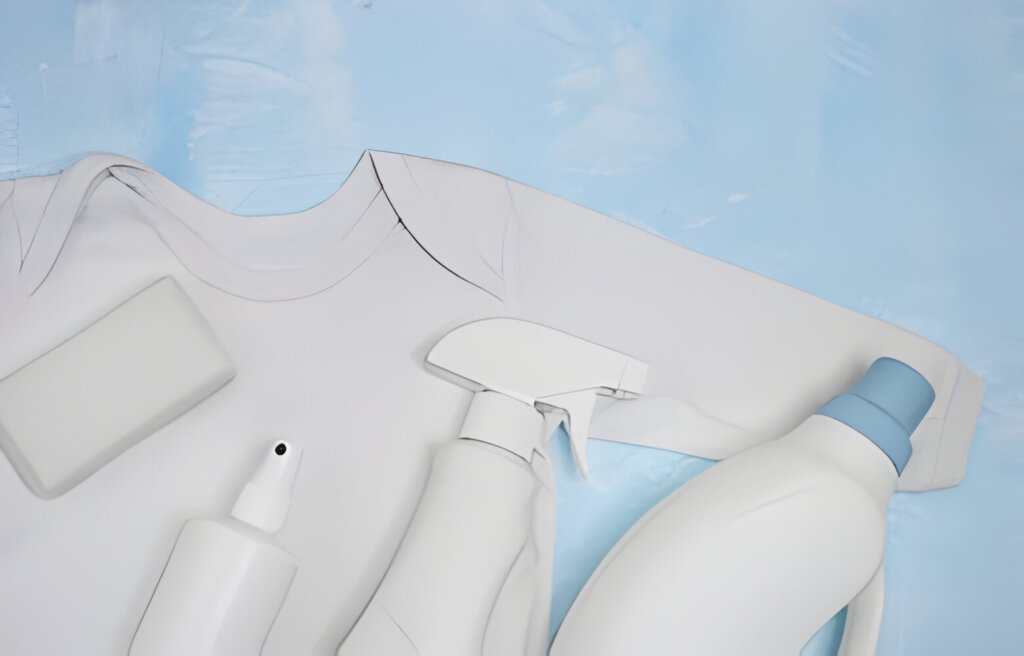
It takes eight to ten minutes for the bleach to truly penetrate the cloth. The bleach may rip your clothing if you leave it on for an extended period of time. When the allotted time is up, wash the clothing with a moderate detergent.
How Much Bleach do You Put on White Clothes?
Use guidelines are included with bleach products, and they must be followed for safety and effectiveness. However, you can vary the amount of bleach you use based on variables such as water quality, soil level, washer type, and load size.
It is advisable to use more bleach than the minimum amount in cases with heavier loads, dirtier clothing, and hard water. For instance, you would add ½ cup of ordinary bleach to a small or lightly soiled load in a conventional washer and 2/3 cup to a large or substantially soiled load.
Because a bleach dispenser usually has to limit the quantity of ordinary bleach that may be employed, manually adjusting the amount of bleach for soil load in high-efficiency washers can be challenging. Fill the dispenser to the maximum fill line for optimal performance, and think about doing fewer loads of laundry if it is filthy.
Note: Generally speaking, one gallon of water should include around 1/4 cup of bleach. Don’t use too much bleach. For an ordinary load, that equals ¾ cup, and for an extra-large or highly filthy load, it equals 1¼ cup.
How to Preserve White Clothing
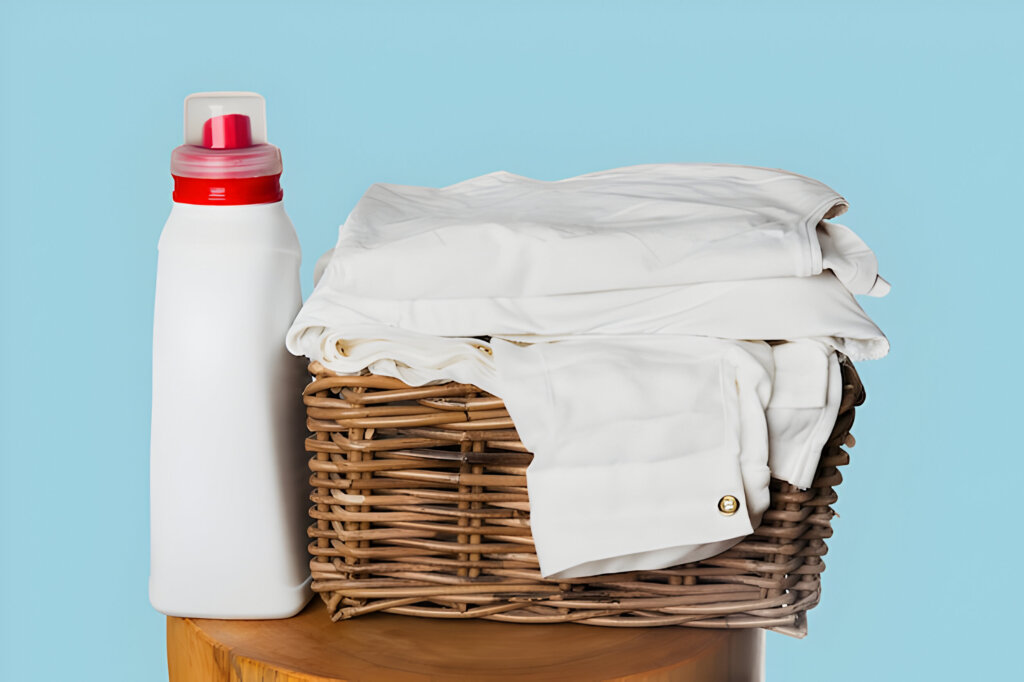
Even though your clothes are now the right shade of white, normal wear and tear and grime might turn them yellow or dingy again. The following are some tips to keep white hues vibrant, stain-free, dullness-free, and discoloration-free:
- Pretreating spills as soon as they occur: As soon as you see a stain, employ a stain remover; you can also use commercial stain remedies or vinegar.
- Wash white clothing in tandem: Make sure to organize and wash white clothes with bleach apart from all other colors, including gray, to prevent color transfer while washing whites with bleach.
- Hang in the sun to dry: Every time you wash your whites, it’s a good idea to dry them in the sun, even if you’re not going to go all out with the sun-bleaching procedure.
FAQs
How Long Should I Leave Clothes in Bleach to Whiten?
Bleach-soaking degrades the cloth. Never let the soak time exceed 20 minutes, and never use more than one cup per load. Both the quantity and the duration are crucial elements. The bleach and water mixture shouldn’t be left together for longer than it takes to fill a typical washer, in my opinion.
Which Bleach Works Best for Whitened Clothing?
Helping individuals maintain the whitest possible clothing has been the cornerstone of Clorox’s brand image. Clorox Bleach might assist if you’ve discovered that the color of your white apparel isn’t as vivid as it once was.
Can I use Vinegar for Bleaching Clothes?
Laundry can be bleached with vinegar to remove stains and brighten white garments.
How can I Maintain the Whiteness of My White Clothes Without Using Bleach?
Citrus acid, found in lemons, can bleach polyester, cotton, and linen fabrics. In a sink or plastic basin, combine one-half cup of bottled lemon juice (or the juice of four lemons) with one gallon of hot water. After adding the white clothing, let them soak for four hours or overnight. As usual, wash.
Which Works Better to Whiten Clothes—Baking Soda or Vinegar?
While vinegar can be an incredible tool for getting those whites extra dazzling and getting rid of mildew stink, baking soda can be a terrific addition to the laundry as a natural fabric softener or to reduce unwanted suds. Even the greatest washing detergents benefit from their increased efficacy.
Conclusion
A quick and easy way to revive the appearance of your white clothing is by bleaching it. You may quickly and safely bleach your white garments with the three easy methods in this article, using little time or effort. Bleaching is a terrific way to keep your whites in perfect condition, whether you want to make them brighter or want to get rid of stubborn stains. For optimal results, make sure you read the care label on the clothing and adhere to the guidelines.

